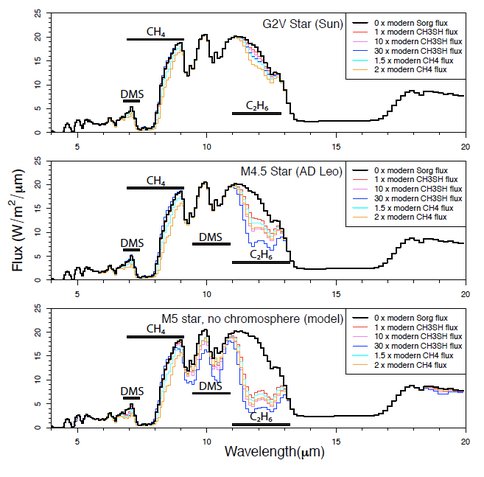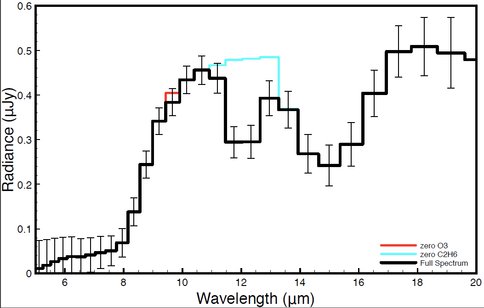2010 Annual Science Report
 VPL at University of Washington
Reporting | SEP 2009 – AUG 2010
VPL at University of Washington
Reporting | SEP 2009 – AUG 2010
Detectability of Biosignatures
Project Summary
In this project VPL team members explore the nature and detectability of biosignatures, global signs of life in the atmosphere or on the surface of a planet. Work this year focused on the build up and detectability of sulfur-based biosignatures in early Earth-like atmospheres, especially for planets orbiting stars cooler than our Sun. We also explored the potential non-biological generation of oxygen and ozone in early Earth-like atmospheres, which could result in a “false positives” for photosynthetic life. In parallel, we worked on acquiring and getting running two simulators for telescopes that will one day be able to observe and determine the properties of extrasolar terrestrial planets.
Project Progress
We have been researching biosignatures from metabolisms other than oxygenic photosynthesis, which are more likely to be prevalent in early Earth type atmospheres, and for planets orbiting stars cooler than our Sun. We have also explored the potential for abiotic false positives for early Earth like planets orbiting cooler stars. These two projects are described in more detail below. In parallel, we have obtained and are now running simulators for Terrestrial Planet Finder Coronograph (S. Heap and D. Lindler) and Interferometer (T. Velusamy) mission concepts. We are using these simulators to explore the detectability of signs of habitability and biosignatures from oxygenic photosynthetic, as well as the other metabolisms described here (Evans et al., 2010).
Biosignatures in Anoxic Atmospheres
For planets like the early Earth, in which oxygenic photosynthesis has not yet evolved or has not yet produced detectable levels of oxygen and ozone, identification of biosignatures from alternative metabolisms is important. This year we used photochemical and radiative transfer modeling to explore the potential of various sulfur-bearing biogenic gases to act as biosignatures for anoxic planets similar to the early Earth, and in orbit around stars of different spectral type (Domagal-Goldman, et al., submitted). Our results (Figure 1) indicate that these gases – methyl mercaptan (CH3SH), in particular – may build up to detectable concentrations on planets around quiescent M-dwarfs (bottom panel). On planets around G-dwarfs like the Sun (top panel) or active M-dwarfs like AD Leo (middle panel) the spectral features of CH3SH and other biogenic sulfur species are not detectable. However, absorption features from ethane (C2H6) are much deeper due to the methyl (CH3) groups attached to the biogenic sulfur gases. C2H6 could be a byproduct of photolysis of abiotic CH4. However, these spectra can be distinguished from those that contain abiological C2H6 if methane (CH4) concentrations can be constrained from the width of the CH4 absorption features.
Abiotic Formation of Ozone On Planets Around M dwarfs
While studying the photochemistry of anoxic atmospheres around other star types, we discovered the unexpected presence of ozone (O3) in anoxic atmospheres on planets around active M-dwarfs. This results from the production of O atoms from photolysis of O2, H2O, and CO2 with short-wavelength photons that arise from stellar activity, and a lack of longer-wavelength photons that are responsible for O3 photolysis. This allows for a detectable buildup of O3 in an atmosphere, even if O2 concentrations are at low, abiotic levels (Figure 2). These results are being prepared for publication.
Mid-infrared spectra showing the position and relative strengths of absorption bands of biogenic gases produced by sulfur-based metabolisms. The three panels show the results for a planet orbiting the Sun, an active M dwarf and an M dwarf with no stellar activity. The difference colored spectra in each panel correspond to different levels of planetary surface flux of biologically generated sulfur gases or methane. The most detectable feature of the sulfur metabolism is ethane, which can be produced both by methane photolysis, and the release of methyl groups from biologically generated sulfur gases. Quantifying the amount of methane in the planet’s atmosphere may help to discriminate between these two sources.
Simulated Terrestrial Planet Finder Interferometer spectrum of ozone (red discrepancy at 9.6 microns) generated by photochemistry alone on an anoxic early Earth-like planet orbiting an M dwarf star.
Publications
-
Robinson, T. D., Meadows, V. S., & Crisp, D. (2010). DETECTING OCEANS ON EXTRASOLAR PLANETS USING THE GLINT EFFECT. The Astrophysical Journal, 721(1), L67–L71. doi:10.1088/2041-8205/721/1/l67
- Demarines, J., Cash, W., Domagal-Goldman, S. & Meadows, V. (2010). Remote Detection of Biosignatures of Primitive and Evolved Life on Extrasolar Planets.
- Domagal-Goldman, S., Meadows, V.S., Kasting, J. & Claire, M. (2010). Astronomical Biosignatures for Sulfur-Rich Anoxic Biospheres.
- Domagal-Goldman, S.D. & Meadows, V.S. (2010). False positives for life: A new meathod for abiotic ozone accumulation in exoplanet atmospheres.
- Evans, N., Meadows, V.S. & Domagal-Goldman, S. (2010). Exploring the Detectability of Terrestrial Exoplanet Characteristics.
-
PROJECT INVESTIGATORS:
-
PROJECT MEMBERS:
Mark Claire
Co-Investigator
James Kasting
Co-Investigator
Nicole Evans
Undergraduate Student
Noe Khalfa
Undergraduate Student
-
RELATED OBJECTIVES:
Objective 1.1
Formation and evolution of habitable planets.
Objective 1.2
Indirect and direct astronomical observations of extrasolar habitable planets.
Objective 4.1
Earth's early biosphere.
Objective 6.2
Adaptation and evolution of life beyond Earth



